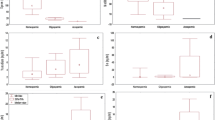Abstract
Purpose
There has been an increasing interest in the evaluation of metal ion concentration, present in different body fluids. It is known that metal ions, especially zinc play vital role in the fertility of human semen.
Objective
The main objective of the study is to evaluate the Zn concentration in Normospermia samples by Atomic absorption spectroscopy (AAS) and to predict the same by artificial neural network (ANN).
Materials and methods
Normospermia semen samples were collected from the patients who came to attend semen analysis at Bangalore assisted conception centre, Bangalore, India. Semen analysis was done according to World Health Organization (WHO) guidance. Atomic absorption spectroscopy was used to estimate the total Zn in these samples, while the Back propagation neural network algorithm (BPNN) was used to predict the Zn levels in these samples.
Results
Zinc concentration obtained by AAS and BPNN indicated that there was a good correlation between the estimated and predicted values and was also found to be statistically significant.
Conclusion
The BPNN algorithm developed in this study could be used for the prediction of Zn concentration in human Normospermia samples.
Future perspective
The algorithm could be further developed to predict the concentration of all the trace elements present in human seminal plasma of different infertile categories.





Similar content being viewed by others
References
Adamopoulos DA, Deliyiannis V. Seminal plasma magnesium, calcium and inorganic phosphate concentration in normozoospermic and subfertile men. Andrologia. 1983;15:648–54.
Azuaje F, Dubitzky W, Lopes P, Black N, Adamson K, Wu X, White JA. Artif Intell Med. 1999;15:275.
Bakalczuk S, Robak-Cholubek D, Jakiel G, Krasucki W. Level of zinc and magnesium in semen taken from male partners of married infertile couples. Ginekol Pol. 1994;65:67–70.
Bishop CM. Neural networks for pattern recognition. Oxford Univ Pr; 2005.
Carpino A, Siciliano L, Petroni MF, De Stefano C, Aquila S, Ando S, et al. Low seminal zinc bound to high molecular weight proteins in asthenozoospermic patients: evidence of increased sperm zinc content in oligoasthenozoospermic patients. Hum Reprod. 1998;13:111–4.
Caldamone AA, Freytag MK, Cockett AT. Seminal zinc and male infertility. Urology. 1979;13:280–1.
Colagar AH, Marzony ET, Chaichi MJ. Zinc levels in seminal plasma are associated with sperm quality in fertile and infertile men. Nutr Res. 2009;29:82–8.
Gil D, Girela JL, De Juan J, Jose Gomez-Torres M, Johnsson M. Predicting seminal quality with artificial intelligence methods. Expert Syst Appl. 2012;39:12564–73.
Dimopoulos I, Chronopoulos-Serelia JA, Lek S. Neural network models to study relationships between lead concentration in grasses and permanent urban descriptors in Athens city (Greece). Ecol Model. 1999;120:157–65.
Ebisch IMW, Thomas CMG, Peters WHM, Braat DD, Steegers-Theunissen RPM. The importance of folate, zinc and antioxidants in the pathogenesis and prevention of subfertility. Hum Reprod Update. 2007;13:163–74.
Fuse H, Kazama T, Ohta S, Fujiuchi Y. Relationship between zinc concentrations in seminal plasma and various sperm parameters. Int Urol Nephrol. 1999;31:401–8.
Hayashi Y, Setiono R, Yoshida K. Artif Intell Med. 2000;20:205.
Ho E, Ames BN. Low intracellular Zinc induces oxidative DNA damage, disrupts P53, NFκB, and AP1 DNA binding, and affects DNA repair in a rat glioma cell line. Cell Biol. 2002;99:16770–5.
Johnston SD, Osborne CA, Lipowitz AJ. Characterization of seminal plasma, prostatic fluid, and bulbourethral gland secretions in the domestic cat. In: Proceedings of the 11th International Congress on Animal Reproduction and Artificial Insemination, Dublin, 1988;4:560.
Kaufmann SJ, Eastaugh JL, Snowden S, Smye SW, Sharma V. The application of neural networks in predicting the outcome of in-vitro fertilization. Hum Reprod. 1997;12(7):1454.
Kshirsagar AV, Murthy L, Chelu L, Lamb D, Ross L, Niederberger C. Predicting outcomes for intracytoplasmic sperm injection. Fertil Steril. 2005;84:274.
Linneberg C, Salamon P, Svarer C, Hansen LK, Meyrowitsch J. Towards semen quality assessment using neural networks. In Neural networks for signal processing [1994] IV. Proceedings of the 1994 IEEE workshop (pp. 509–517). IEEE; 1994.
Ma Y, Chen B, Wang HX, Hu K, Huang YR. Prediction of sperm Retrieval in men with non-obstructive azoospermia using artificial neural networks: leptin is a good assistant diagnostic marker. Hum Reprod. 2011;26(2):294.
Marmar JL, Katz S, Praiss DE, De Benedictis TJ. Semen zinc levels in infertile and post vasectomy patients and patients with prostatitis. Fertil Steril. 1975;26:1057–63.
Ripley BD. Pattern recognition and neural networks. Cambridge University Press; 1996.
Shetty GR, Chellam S. Predicting membrane fouling during municipal drinking water nanofiltration using artificial neural Networks. J Membrane Sci. 2003;217:69–86.
Sorensen MB, Stoltenberg M, Danscher G, Ernst E. Chelating of intracellular zinc ions affects human sperm cell motility. Mol Hum Reprod. 1999;5:338–41.
Tapiero H, Tew KD. Trace elements in human physiology and pathology: zinc and metallothioneins. Biomed Pharmacother. 2003;57:399–411.
Tsalev DL, Zaprianov ZK. Atomic absorption spectrometry in occupational and environmental health practice, Analytical Aspects and Health Significance, vol. I. USA: CRC Press Inc; 1983.
Vallee BL, Falchuk KH. The biochemical basis of zinc physiology. Physiol Rev. 1993;73:79–118.
Wald M, Sparks AET, Sandlow J, Van-Voorhis B, Syrop CH, Niederberger CS. Computational models for prediction of ivf/icsi outcomes with surgically retrieved spermatozoa. Reprod BioMed Online. 2005;11(3):325–31.
Wong WY, Flik G, Groenen PM, Swinkels DW, Thomas CM, Copius-Peereboom JH, et al. The impact of calcium, magnesium, zinc, and copper in blood and seminal plasma on semen parameters in men. Reprod Toxicol. 2001;15:131–6.
World Health Organization. WHO laboratory manual for the examination and processing of human semen. 2010; 5th eds. pp 7–36, 56–102.
Acknowledgments
The authors wish to acknowledge the management of both the institutes, VIT University and BACC, for support towards the execution of this study.
Author information
Authors and Affiliations
Corresponding author
Additional information
Capsule
Back propagation neural network can be used for predicting the concentration of Zn in normospermia human semen samples.
Rights and permissions
About this article
Cite this article
A. S., V., Das, R., M. S., S. et al. Prediction of Zn concentration in human seminal plasma of Normospermia samples by Artificial Neural Networks (ANN). J Assist Reprod Genet 30, 453–459 (2013). https://doi.org/10.1007/s10815-012-9926-4
Received:
Accepted:
Published:
Issue Date:
DOI: https://doi.org/10.1007/s10815-012-9926-4




